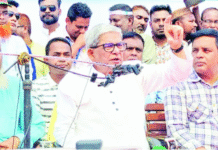Immediately repair the coastal embankment where needed

The whole nation heaved a sigh of relief as cyclone Amphan did not hit the country as badly as we feared it would. Had Amphan—the first “super cyclone” created over the Bay of Bengal in this century—made its landfall in Bangladesh, it would have completely ravaged our coastal regions. The places of West Bengal where it had hit Wednesday afternoon are in a bad shape now, despite the fact that the cyclone had weakened and turned into an “extremely severe cyclonic storm” when it landed there. While we have been spared the worst, the devastation done by Amphan in our coastal regions is still enormous, and massive work needs to be done to bring life back to normal in the affected areas.
As of yesterday, at least 10 people were reported to have been killed by the cyclone. Hundreds of villages, particularly in Satkhira, Jessore, Khulna, Patuakhali and Borguna, were submerged by the high tidal surge. While parts of the coastal embankment were washed away in some places, cracks or breaches developed in many other points through which sea water is still entering inside the embankment, inundating dwellings of hundreds of people. Drinking water crisis would be a major issue in these areas in the coming days. In Rajshahi, Naogaon and Pabna mango and litchi orchards were ravaged, while paddy fields in many districts went under water as the cyclone passed through the country Wednesday night. It will definitely need some time to assess the losses and damage done by the cyclone, but whatever news we have got from the affected areas is enough to make us concerned.
We are fortunate enough to have Sundarbans stretching along our coastal districts. The 6,017 sq km mangrove forest has always been our greatest saviour in times of natural disasters like cyclones. Had the forest not absorbed the fury of Amphan, its impacts on our coastal areas would have been more severe. Since the Sundarbans has been acting like a shock absorber, economic and commercial interventions that threaten the forest’s ecological balance should be stopped immediately to save this unique forest.
Now, the biggest challenge for the government would be to minimise the sufferings of the cyclone-affected people. It should immediately start rehabilitation and relief operations in the affected areas, for which inter-ministerial coordination is needed. Safe drinking water should be made available for people. In addition, the coastal embankment should be repaired, where needed, on an urgent basis to stop sea water from entering inside. The government also needs to make a better plan to maintain the embankment throughout the year, as breaches in the embankment often cause sufferings to those living in the coastal areas.
Last but not the least, as the government did a commendable job of evacuating people to the cyclone shelters at the right time, we hope that it will also take the necessary precautions for containing the Covid-19 spread in the affected areas, as lakhs of people are now leaving the shelters for their homes.









